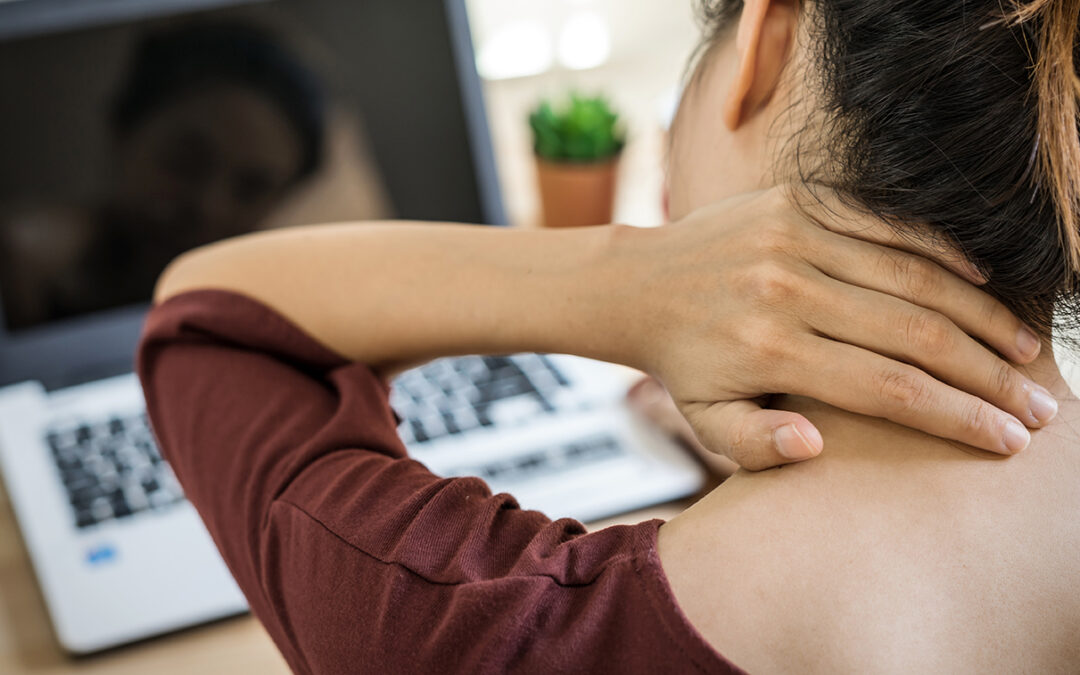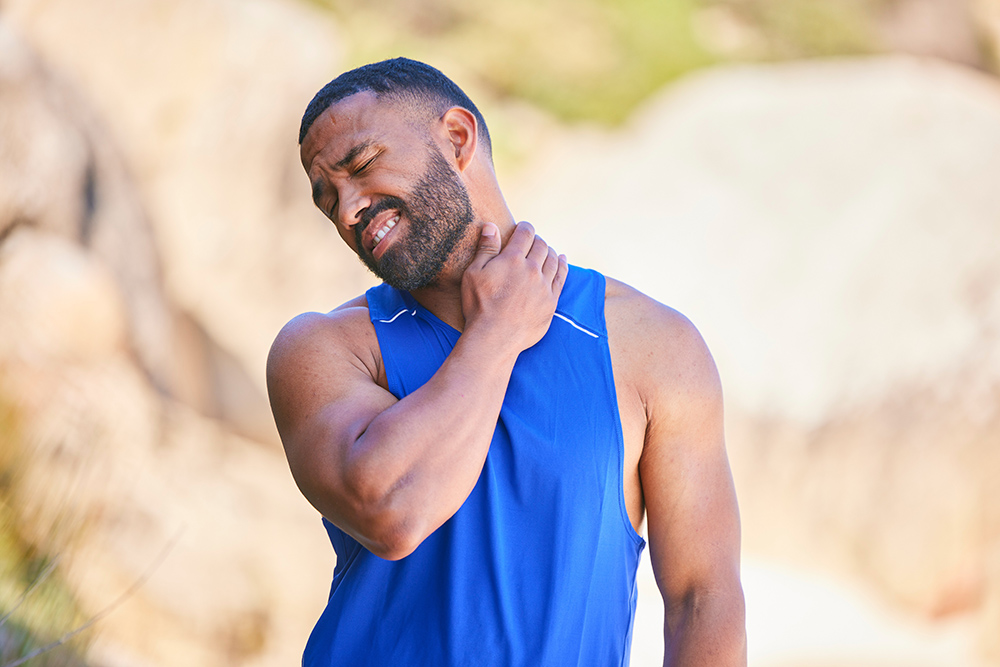Contents
Living with pain on the left side of your neck can be incredibly frustrating. Even mild neck pain may hinder you from living the life you want, and odds are you’ll encounter it eventually. One study estimates that around 80% of people will deal with neck pain at some point in their lives.
Since neck pain is so common, how do you know when to start worrying about it? Most of the time, neck pain isn’t something to be concerned about. But if your neck pain is severe, persistent, or comes with other troubling symptoms, you should see a doctor immediately. Discover some common causes of neck pain, how to treat it, and when you should seek professional help.
Top reasons for pain on the left side of your neck
Pain on the left side of your neck isn’t always cause for serious concern, but there can be many different reasons for it. Let’s take a look at some of the most common causes of neck pain that you may be experiencing.
- Muscle strain or tension — One of the most common causes of neck pain is due to muscle strain or tension. There are a lot of muscles in and around your neck, and if that tissue gets stretched or torn, it can cause muscle strain. Muscle tension is when the muscle contracts but cannot fully release. You can develop muscle strain or tension due to many different things, such as:
- An awkward sleeping position, such as with the neck bent or twisted to one side.
- Being hunched over or leaning forward for long periods of time.
- Holding a phone between your ear and your shoulder.
- Lifting heavy objects or exercising in a way that overexerts the neck muscles.
- Collisions, falls or other injuries that cause whiplash.
- Grinding your teeth.
- Stress and holding tension in your muscles.
Muscle strain or tension can cause more symptoms than just pain in the side of the neck. It can also cause stiffness, headaches, decreased flexibility, swelling or spasms in the neck and shoulder, and numbness or tingling in the arms.
- Torticollis — Also called “wryneck,” torticollis is a medical condition that makes the neck bend, twist or tilt to one side. This usually occurs when the neck muscles forcibly contract. A number of things can cause this, including:
- Injuries or accidents.
- Congenital conditions.
- Infections.
- Emotional stress.
- Neurological conditions, such as compressed nerves or a stroke.
- Exposure to cold temperatures.
- Some medications.
Torticollis can cause a lot of unpleasant symptoms, such as pain and difficulty when straightening or moving the neck, headaches, trouble balancing, vision problems, difficulty walking, nausea, vomiting, and fever. Mild torticollis can typically be resolved within a few days using heat therapy, massage and stretching exercises to relax the affected muscles.
- Cervical radiculopathy — This occurs when the root of a nerve in the cervical spinal cord gets compressed. The compressed or “pinched” nerve can cause neck pain that radiates down the arm and into the hand. Cervical radiculopathy can be caused by:
- A herniated disc.
- Bone spurs.
- Inflammation.
Cervical radiculopathy can cause a number of symptoms, including numbness or tingling in the arm, muscle weakness, reduced reflexes, and a pins-and-needles sensation in the arm.
- Cervical spinal stenosis — Cervical spinal stenosis can occur when the spinal canal in the neck narrows. This puts pressure on the spinal cord and nerve roots, causing neck pain. Age-related changes are a common root cause of cervical spinal stenosis, but there are several other conditions that can contribute to your pain, for example:
- Rheumatoid arthritis.
- Osteoarthritis.
- Injuries of the spine.
- Paget’s disease or other bone conditions.
- Spinal cord tumors.
Since symptoms develop gradually, you may not experience any during the early stages of cervical spinal stenosis. Once you do experience symptoms, they can include pain or cramping in the neck, numbness or tingling that begins in the neck and radiates down into the arms and hands, and weakness in the arms, hands or fingers.
- Cervical disc conditions — The cervical or neck discs are tissue sandwiched between the vertebrae of the neck. These discs are flexible and serve as shock absorbers that allow your neck to bend and twist without pain. If something happens to these discs, neck pain can occur. Some common issues that can happen to cervical discs are:
- Disc degeneration, where the internal fluid of the disc comes out and accumulates on the spine.
- Disc herniation, where a tear in the disc allows the nucleus to push through and put pressure on the nerves and spinal cord.
These conditions can cause pain in the left side of the neck, numbness, stiffness and arm pain.
- Cervical fracture — The cervical vertebrae at the top of the spine support the head and neck. If these bones fracture, it can lead to debilitating pain. This is also referred to as a broken neck. Some common things that can cause cervical fractures are:
- Violent contact sports or exercise.
- Falls.
- Car accidents.
- Traumatic injuries.
Fractures in any of the cervical vertebrae can cause severe pain in the neck, and the most serious risk with a cervical fracture is damage to the spinal cord. If you think you have a cervical fracture, seek medical treatment right away.
- Meningitis — Meningitis causes inflammation of the fluid and membranes that surround the brain and spinal cord. While less common than other conditions, it can still cause neck pain. Usually, meningitis is caused by a virus, but it can also be a result of other infections, such as:
- Bacterial.
- Fungal.
- Parasitic.
Meningitis can cause symptoms such as muscle stiffness, pain in the neck and headaches. If left untreated, it can lead to life-threatening complications such as seizures and brain swelling. If you think you have meningitis, seek medical treatment right away.
While most causes of pain in the left side of the neck aren’t serious, it can be helpful to know the cause of your pain. However, if your neck pain is severe, persistent, or accompanied by symptoms such as vomiting, fever, or loss of coordination, you should see a doctor immediately.
How to treat pain on the left side of your neck
Once you know what’s triggering your symptoms, you can begin to treat it. For mild or moderate neck pain, you may not need professional treatment. At-home remedies such as rest and over-the-counter medications may be enough to help you heal. If you need more than just a few days off your feet, though, here are a few treatment options you can talk with your doctor about:
- Physical therapy — Physical therapy can be a highly effective treatment for pain on the left side of your neck. Your physical therapist can assess your pain and develop a unique treatment plan to address it. Physical therapy may also help you avoid more invasive treatment options like surgery later on down the line.
- Corticosteroid injections — For addressing inflammation in the neck, your doctor may recommend corticosteroid injections as another treatment option. This medication is usually injected in the joint nearest the site of pain and can help relieve pain for weeks or months. This is most beneficial for injuries that need a short amount of time to heal and can do so on their own or with physical therapy.
- Surgery — This treatment method is usually only for conditions where other less invasive treatments have failed. It can correct serious spinal issues and help with severe conditions.
Pain on the left side of your neck doesn’t have to slow you down. Address your neck pain now and start your road to recovery with our team at Lattimore PT. Our licensed physical therapists are expertly trained to help you find relief for your neck pain. If you’re ready to take the next step toward addressing your neck pain, contact our team today for more information or to schedule an initial appointment.



